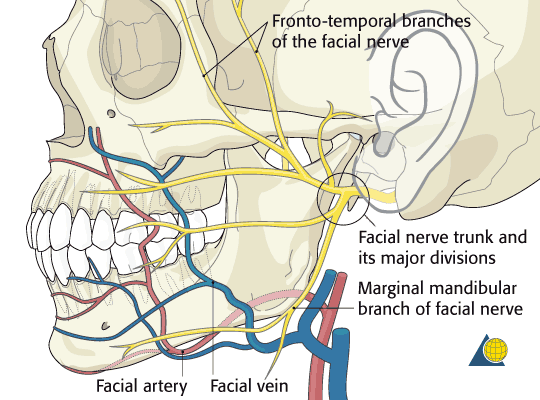Your most important expression i.e. smile, is a very precious gift of nature. The smile of an individual is generated by the lips to record the expressions and emotions. Hence, a very minor change in the symmetry of the mouth and lips can convert a smile into many undesirable and awkward emotions. The musculature around the mouth and lips is the main culprit for all the expressions we make. Those muscles are supplied by the marginal mandibular branch of the facial nerve. Consequently, any injury to marginal mandibular nerve, either due to any trauma or due to surgical interventions can lead to misrepresentation of many expressions along with your precious smile.
What Is the Marginal Mandibular Nerve?

Facial nerve is the mainstay source of nerve innervation of the oral muscles which are required for the maintenance of normal expressions and facial movements. The facial nerve is the seventh (VII) cranial nerve, with a mixed functional capacity i.e. both sensory and motor domains. It is responsible for motor functions of facial expression muscles and for the control of lacrimal secretions and gustatory secretions. The damage to facial nerve therefore causes salivary incontinence and undesirable facial muscles functions. There are five branches of facial nerve that supply the face.
The marginal mandibular branch of facial nerve:
The marginal mandibular nerve is one of the major branches which is anatomically situated at a very vulnerable position. During its passage beneath the Platysma muscle and Depressor Anguli Oris, it supplies the muscles of lower lip and the chin and ends by communicating with the inferior alveolar nerve.
Muscles supplied by marginal mandibular nerve:
- Depressor labii inferioris- depresses the lower lip downand laterally.
- Depressor anguli oris- depresses the angle of mouth downand laterally.
- Mentalis- elevates and projects the lower lip out.
Clinical significance:
The risk of injury increases with certain surgical approaches, such as trans-facial approach. That approach is made to enter the posterior and lateral surfaces of the mandible. Other procedures include submandibular gland excision, facelift tactics, and liposuction, etc.
The marginal mandibular branch of facial nerve can also be damaged during a neck dissection. It can occasionally be injured during other cervical surgeries, parotidectomies, mandibular fracture reductions, rhytidoplasty and many other surgeries along the mandibular and neck region.
Marginal Mandibular Nerve Injury Symptoms and Treatments
The injury to this nerve represents as a severe defect of opening of the mouth, distortion in smiling and grimace. It occurs due to paralysis of musculature of lower lip. The rectification of the damage done might require some compound surgical techniques such as transfer of the belly of Digastric muscle or Extensor Digitorum Brevis. Conclusively, a very broad field of knowledge is required about this nerve, as to prevent the damage and paralysis.
The injury treated by the complex forms of surgical interventions takes six to eight weeks for the improvement of functions. By that time the patients can squeeze the improvement time by using a few simple techniques. The following video shares the techniques and treatment options for the marginal mandibular nerve weakness:
More About Facial Nerves Injuries and Repair
The facial nerve is usually injured at three positions; intra cranially, intra temporally and extra temporally.
- Intracranial (within the skull) injury to the facial nerve more frequently occur during cerebellopontine angle (CPA) tumor resection or acoustic neuroma resection.
- Intra-temporal injury to the facial nerve occurs due to head trauma and surgical procedures tend to approach the lesion via ear and its surroundings. The fracture of temporal bone is the most common mechanism of injury to facial nerve during a motor vehicle accident. Moreover, the intra-temporal cause of paralysis of facial nerve includes mastoidectomy and tympanoplasty.
- The extra temporal cause of facial nerve injury includes lacerations of face due to trauma, parotidectomy, submandibular gland resection and temporomandibular joint surgeries. Moreover, due to these injuries of facial nerve, synkinesis occurs, causing involuntary movement of facial muscles including eyes, mouth, midface and neck. Increase in lacrimation is also its effect.
The repair of facial nerve depends upon the part of facial nerve that gets damaged and the extent to which the damage occur. The nerve can be substituted or transferred in the patients whose distal pathway of nerve is intact, that is the proximal end of nerve is damaged only. In that case the nerve can be anastomosed and the functions can be resumed. It can be done by grafting the nerve. The common grafts include hypoglossal nerve graft and cross-facial grafts. Transposition of muscles is helpful in cases of nerve injury exceeding 18 months or more. The muscles, such as temporalis, masseter and digastric can be positioned at the place of paralysis carrying there same and original nerve and vascular supply. In case of synkinesis, Botulinum toxin A and physiotherapy plays an important role. Botulinum toxin A provides selected relaxation of the muscles of face and neck when injected repeatedly after every 4-5 months.
